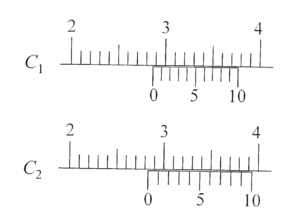Two full turns of the circular scale of a screw gauge cover a distance of on its main scale. The total number of divisions on the circular scale is Further, it is found that the screw gauge has a zero error of While measuring the diameter of a thin wire, a student notes the main scale reading of and the number of circular scale divisions, in line with the main scale, as The diameter of the wire is
Important Questions on Units and Measurements
The figure of a centimetre scale below shows a particular position of the Vernier calipers. In this position, the value of shown in the figure is (figure is not to scale):

The readings of the main scale and the circular scale, for a thin sheet, are and respectively, the thickness of this sheet is:
| S.No. | MS (cm) | VS divisions |
| 1. | 0.5 | 8 |
| 2. | 0.5 | 4 |
| 3. | 0.5 | 6 |
If the zero error is - 0.03 cm, then mean corrected diameter is:
The vernier scale used for measurement has a positive zero error of If while taking a measurement it was noted that on the vernier scale lies between and . Vernier coincidence is then the correct value of measurement is
(least count)
If in five complete rotations of the circular scale, the distance travelled on the main scale of the screw gauge is and there are total divisions on a circular scale, then the least count is
Least Count
In the light of the above statements, choose the most appropriate answer from the options given below.
There are two vernier calipers both of which have divided into equal divisions on the main scale. The Vernier scale of one of the calipers has equal divisions that correspond to main scale divisions. The Vernier scale of the other caliper has equal divisions that correspond to main scale divisions. The readings of the two calipers are shown in the figure. The measured values (in ) by calipers and respectively, are


